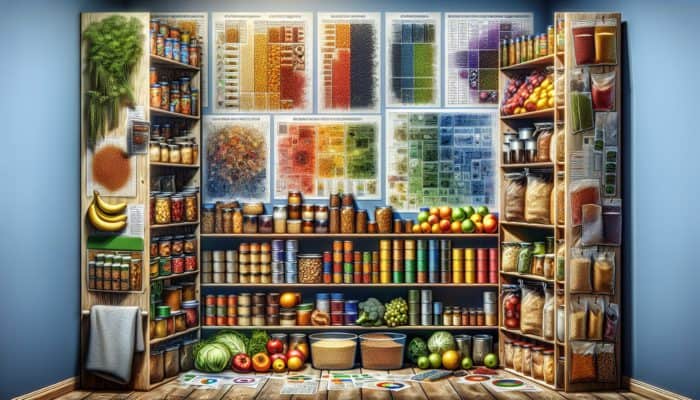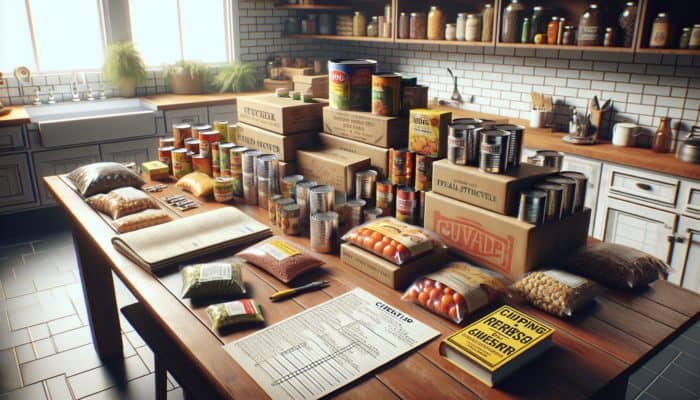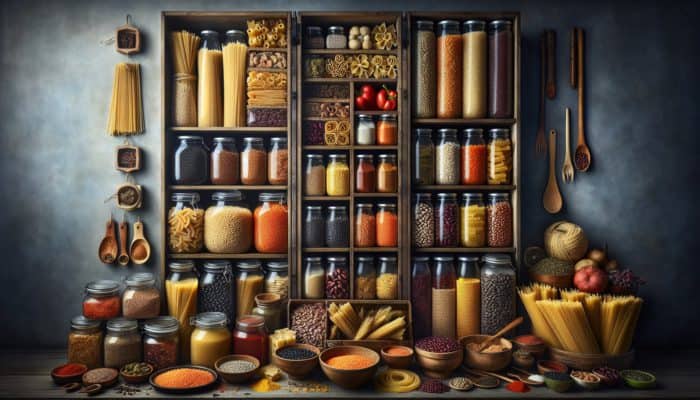Mastering the Art of Prepper Meal Planning for Emergencies
Essential Principles of Effective Prepper Meal Planning

Prepper Meal Planning: Understanding the fundamentals of Prepper meal planning is crucial for anyone looking to enhance their emergency preparedness. This strategic approach is designed to equip individuals and families with the necessary tools, resources, and knowledge to thrive during unforeseen circumstances. The core concept revolves around the prudent stockpiling of essential foods that not only boast a long shelf life but also deliver the vital nutrients required to maintain energy levels and overall health during crises. Rather than merely hoarding supplies, successful prepper meal planning emphasises thoughtful preparation and foresight, ensuring that you remain well-prepared and confident when faced with unexpected challenges.
A harmonious balance between variety and nutrition characterises a successful prepper meal planning strategy. When selecting foods for your stockpile, it’s essential to focus on items that are versatile and can be incorporated into a variety of meals. Furthermore, a comprehensive understanding of food preservation methods is indispensable. Techniques such as dehydration, canning, and the use of airtight containers play a significant role in extending the shelf life of your food supplies, thereby increasing their reliability during emergencies. By embracing these foundational principles, you create a robust safety net that protects against potential food shortages or disruptions in the supply chain.
An equally critical aspect of effective prepper meal planning is maintaining a thorough inventory of your stockpile. Keeping track of expiration dates and regularly rotating your supplies ensures that nothing goes to waste. Additionally, it is beneficial to familiarise yourself with local food resources. Knowing where to source emergency supplies can significantly impact your ability to maintain a steady food supply in times of need. Ultimately, mastering the basics of prepper meal planning empowers individuals to approach emergencies with confidence, resilience, and a sense of preparedness.
Setting Clear Objectives for Successful Prepper Meal Planning
Establishing clear objectives within your prepper meal planning framework is vital for cultivating an effective and sustainable strategy. Your goals should centre on sustainability, variety, and ease of preparation—all of which are essential elements that enhance your resilience during emergencies. Sustainability entails selecting foods that are not only long-lasting but also environmentally responsible. This includes prioritising local, organic options whenever possible, which helps reduce your carbon footprint while supporting local agriculture.
Incorporating variety into your stockpile plays a pivotal role in alleviating the monotony often associated with emergency meals, particularly during extended crises. By diversifying your food options, you can create meals that are not only nutritious but also enjoyable to consume. This might involve integrating different global cuisines, such as Mexican beans, Italian pasta, or Asian rice dishes, ensuring that your diet remains varied and appealing, even in the face of adversity.
Ease of preparation is another critical goal that should not be overlooked. During emergencies, the last thing you want is to struggle with complex cooking processes. Therefore, it’s wise to focus on meal options that require minimal cooking time and are straightforward to prepare. This could mean selecting pre-packaged meals or dehydrated foods that can be quickly reconstituted. By setting these clear objectives, you ensure that your prepper meal planning efforts are not only practical and efficient but also sustainable, ultimately leading to reduced stress during times of crisis.
The Multifaceted Benefits of Prepper Meal Planning
The advantages of prepper meal planning extend far beyond simply having a food supply readily available. One of the most compelling benefits is the significant reduction in anxiety and uncertainty during emergencies. Knowing that you have a well-stocked pantry allows you to focus on other crucial aspects of preparedness, such as safety measures or communication strategies. This peace of mind can greatly enhance your overall sense of security and confidence in your ability to handle unexpected situations.
Moreover, achieving self-sufficiency is a profound benefit derived from effective meal planning for preppers. By taking control of your food resources, you can lessen your dependence on external systems that may falter during times of crisis. This independence fosters a sense of empowerment and resilience, promoting a proactive mindset when faced with adversity. It encourages individuals and families to develop self-reliance skills, whether through gardening, hunting, or learning to cook with limited resources.
Additionally, prepper meal planning can lead to substantial cost savings over time. By purchasing items in bulk and capitalising on sales, you can significantly reduce your grocery bills. Furthermore, minimising food waste through careful planning and rotation aids in financial management, ensuring that every pound spent contributes to your emergency preparedness. In essence, the benefits of prepper meal planning encompass emotional, practical, and financial dimensions, creating a well-rounded approach to crisis management that empowers individuals to thrive in uncertain times.
Strategically Selecting Foods for Prepper Meals

Identifying Long-Lasting Foods for Your Stockpile
When embarking on your prepper meal planning journey, selecting foods with extended shelf lives is crucial. These items serve as the backbone of your emergency food supply, ensuring a reliable source of nutrition when fresh food may be difficult to obtain. Excellent options to consider include canned goods, dried fruits, legumes, and various grains. For example, canned vegetables and meats not only provide convenience but also retain essential vitamins and minerals, making them invaluable additions to your stockpile.
Another important consideration when selecting long-lasting foods is understanding their specific storage requirements. Certain foods, such as pasta and rice, can last for years if stored properly. Employing methods such as airtight containers, vacuum sealing, or Mylar bags can help prolong the freshness of these essential staples. Additionally, focusing on nutrient density is vital; foods like quinoa or lentils offer a wealth of protein, which is crucial for maintaining energy levels during emergencies.
Beyond traditional staples, it’s wise to explore incorporating freeze-dried meals into your prepper meal planning. These meals can last for a decade or more, preserving their flavor and nutritional value. They can be conveniently prepared with just hot water, making them ideal for situations where cooking resources are limited. By prioritising these long-lasting foods, you ensure a sustainable and reliable food supply that minimises your reliance on external resources when challenges arise.
Ensuring Nutritional Adequacy in Your Meal Planning
A well-rounded prepper meal planning strategy hinges on considering nutrition to maintain health and energy levels during emergencies. In times of crisis, upholding a balanced diet becomes even more critical to support both physical and mental well-being. Prioritising foods that are rich in essential nutrients—such as proteins, carbohydrates, fats, vitamins, and minerals—ensures that you can adequately sustain yourself and your loved ones.
Protein is particularly vital during emergencies, as it aids in tissue repair, supports immune function, and stabilises energy levels. Including a variety of protein sources, such as canned fish, beans, nuts, and powdered protein supplements, can help meet your nutritional requirements. Concurrently, managing carbohydrate intake through complex carbohydrates, such as whole grains, provides a steady energy source, which is crucial for enduring stressful scenarios.
Moreover, it is imperative not to overlook the importance of hydration. Stockpiling clean water and electrolyte-replenishing beverages should be a top priority, as dehydration can have a severe impact on health. Including hydrating fruits and vegetables in your planning, even in their dried or canned forms, contributes to your overall nutritional profile. Thus, the focus in prepper meal planning should always be on enhancing nutritional value while ensuring that the food remains appealing and palatable.
Incorporating Variety into Your Prepper Meals

Integrating variety into your prepper meal planning is essential for maintaining morale and ensuring long-term sustainability. The psychological aspects of eating during stressful times cannot be overstated. A diverse food selection helps prevent dietary monotony, which can lead to dissatisfaction and reluctance to eat. Achieving this can be accomplished by including a mix of different cuisines, flavours, and textures within your stockpile.
For instance, consider incorporating staples from various cultures into your preparations. Stock up on Italian pasta, Indian lentils, Mexican beans, and Middle Eastern spices. By choosing foods that allow for diverse meal preparation, you not only promote nutritional balance but also create a sense of culinary adventure, even in challenging conditions. Preparation can include recipes that allow for adaptations, such as using canned tomatoes as a base for pasta dishes, soups, or stews.
Furthermore, it’s vital to include snacks and comfort foods in your prepper meal planning. Items like granola bars and dried fruits can serve as morale boosters during difficult times. Including treats, even in small quantities, helps maintain a sense of normalcy and comfort, which is vital for mental health. Therefore, a diverse and vibrant stockpile can make the difference between mere survival and truly thriving during emergencies.
Effective Storage Solutions for Your Prepper Meals
Implementing Food Storage Techniques for Longevity
The success of your prepper meal planning hinges significantly on the effectiveness of your food storage techniques. Proper storage is crucial for maximising the longevity of your supplies while minimising waste. Using airtight containers is one of the most effective methods to preserve food. These containers prevent moisture, air, and pests from compromising the integrity of your items, ensuring they remain safe for consumption over extended periods.
Employing vacuum sealing is another powerful method to consider. By removing air from bags before sealing, this technique drastically slows down spoilage and preserves both flavour and texture. For items such as grains, nuts, and dried fruits, vacuum sealing can significantly extend their shelf life. It may be worthwhile to invest in a quality vacuum sealer that can accommodate various food types, allowing you to customise your storage approach based on your stockpile.
Temperature control is also a vital component of effective storage. Keeping your food in a cool, dry place is essential for preventing spoilage. If possible, designate a storage area that maintains a consistent temperature, away from sunlight and moisture. Basements or root cellars can provide ideal conditions for storing many types of food. By employing these storage techniques, your prepper meal planning efforts will yield a sustainable food supply that is both accessible and safe to use.
Organising Your Food Stockpile for Efficiency
An organised food stockpile serves as the backbone of successful prepper meal planning. Developing a systematic approach to categorising your supplies not only streamlines access during emergencies but also ensures that you effectively manage expiration dates and food rotation. Start by categorising your food items into groups such as grains, proteins, vegetables, and fruits. Labelling shelves or containers can further enhance organisation, making it simpler to locate specific items when needed.
Implementing a “first in, first out” (FIFO) strategy is a crucial aspect of managing your stockpile. This practice involves utilising the oldest items first, ensuring that nothing goes to waste due to expiration. Regularly checking and rotating your food supply will help keep your items fresh and safe for consumption. Setting a schedule to review your stockpile every few months allows you to refresh your inventory and adjust your purchasing strategies accordingly.
Creating an inventory list is another effective way to manage your food stockpile. This list should detail the items you have, their quantities, and expiration dates. By maintaining a digital or physical inventory, you can easily track what needs to be replenished and what is nearing its expiration date. This proactive approach ensures that your prepper meal planning remains efficient and effective, even in the face of uncertainty.
Innovative Space-Saving Storage Ideas
Maximising storage space is a fundamental concern for anyone engaged in prepper meal planning. Innovative solutions can help you utilise every corner of your home efficiently, allowing you to stockpile necessary food items without creating clutter. One effective method is to utilise vertical shelving. By stacking shelves up to the ceiling, you free up floor space while making it easier to access your supplies. Using clear storage bins can also provide a quick view of contents at a glance, promoting efficiency in your storage efforts.
Consider implementing multi-tier storage solutions as well. Utilising tiered shelving units or stackable bins enables you to consolidate your supplies while maintaining organisation. This type of system not only optimises space but also allows for easy retrieval of items based on frequency of use. Additionally, storing smaller items within larger containers can help reduce clutter and increase visibility.
Another creative approach involves using underutilised spaces, such as beneath beds or atop cabinets. Investing in storage bins that can slide easily under beds or fit snugly in kitchen nooks can optimize your storage potential while keeping supplies out of sight, contributing to a clutter-free home environment. By embracing these space-saving storage ideas, you ensure that your prepper meal planning remains scalable and practical, even in limited spaces.
Mastering Long-Term Food Preservation Techniques
To ensure the effectiveness of your prepper meal planning, mastering long-term food preservation methods is essential. Techniques such as dehydration, freeze-drying, and canning offer various ways to extend the shelf life of your supplies while preserving their nutritional value. Dehydration entails removing moisture from foods, thereby preventing the growth of bacteria and mould. This method works exceptionally well for fruits, vegetables, and even meats. Investing in a food dehydrator can enable you to prepare snacks and meals in bulk for long-term storage.
Freeze-drying is another advanced preservation technique that retains food’s taste and texture. This process involves freezing the food and subsequently removing moisture through a process known as sublimation. Freeze-dried foods can last for decades, making them a valuable addition to your stockpile. While this method requires specialised equipment, the long-term benefits justify the investment for serious preppers.
Canning is perhaps the most traditional and widely used method of food preservation, allowing you to store seasonal produce for year-round availability. Whether you opt for water bath canning or pressure canning, mastering this skill enables you to store a wide variety of foods, from vegetables to sauces, for extended periods. Each of these long-term preservation methods can significantly bolster your prepper meal planning, ensuring you have nutritious, ready-to-eat meals even during prolonged emergencies.
Creating Emergency Food Storage Kits for Quick Access
Assembling emergency food storage kits is an indispensable component of effective prepper meal planning. These kits should be designed for quick access and ease of use during crises, ensuring that you can sustain yourself and your family without delay. Start by selecting high-calorie, nutrient-dense foods that require little to no preparation. Options like energy bars, canned soups, and dehydrated meals are excellent choices that can provide essential nutrition without complicated cooking processes.
When assembling your kits, consider portion control. Packaging items in single-serving sizes not only simplifies distribution during emergencies but also facilitates precise meal planning. This approach minimizes waste and ensures that everyone receives adequate nutrition. Additionally, including a variety of food types will help maintain morale, so aim for a mix of proteins, carbohydrates, and snacks.
Storing these kits in easily accessible locations is crucial. Designate specific areas in your home, such as a dedicated pantry or under furniture, where your emergency kits can be readily located. Regularly check your kits to ensure food items have not expired and replenish supplies as needed. By thoughtfully creating and maintaining your emergency food storage kits, you enhance your preparedness and resilience in uncertain times, making your prepper meal planning efforts genuinely effective.
Preparing Nutritious Meals During Emergencies
Crafting Simple and Quick Recipes for Emergencies
During emergencies, having a repertoire of simple and quick recipes is essential for effective prepper meal planning. Concentrate on meals that can be prepared with minimal ingredients and effort, yet still provide balanced nutrition. One easy option is to make a hearty bean soup. By utilising canned beans, diced tomatoes, and spices, you can whip up a filling meal in under 20 minutes. This dish is highly adaptable, allowing for the addition of various vegetables or grains that are available in your stockpile.
Another quick recipe involves preparing a pasta dish using dried noodles, canned vegetables, and a jar of sauce. This meal is not only straightforward but can also be prepared using limited water and cooking resources. For those with access to a portable camp stove or solar cooker, the versatility of pasta dishes makes them an excellent choice for a rapid meal that provides both energy and satisfaction.
Additionally, consider prepping no-cook meals, such as grain bowls, using pre-cooked, packaged grains and canned proteins. Combining these elements with canned or dried fruits can yield a nutritious and delicious meal that requires no heating. By compiling a collection of simple recipes, you make your prepper meal planning more manageable, thereby enhancing your ability to respond effectively during emergencies.
Cooking Without Power: Techniques for Emergencies
In a crisis, the ability to cook without power is a critical skill that significantly enhances your prepper meal planning. Exploring alternative cooking methods can open up possibilities for meal preparation when conventional appliances are unavailable. Solar ovens represent a brilliant solution for harnessing the sun’s energy to cook food. These ovens can reach high temperatures, allowing you to bake or cook meals using sunlight, making them particularly useful for emergencies in sunny climates.
Camp stoves and portable grills also serve as excellent alternatives for cooking without electricity. These devices can utilise propane or butane fuel, providing versatile options for meal preparation. Learning to cook using these methods can equip you with the necessary skills to prepare a variety of meals regardless of your power situation. It’s important to practice using these tools ahead of time, ensuring you feel confident during an actual emergency.
Furthermore, mastering techniques such as fire cooking or using a Dutch oven can add depth to your cooking repertoire. Fire cooking not only provides warmth but also allows for grilling and roasting, enhancing the flavour of your meals. By preparing yourself with skills for cooking without power, you can adapt your prepper meal planning to any situation, ensuring food security regardless of the circumstances.
Meal Planning for Diverse Emergency Scenarios
Adapting your prepper meal planning for various emergency scenarios is essential for comprehensive preparedness. Different situations can arise, influencing the availability of resources, cooking facilities, and water accessibility. For instance, in a natural disaster scenario, you may experience limited access to fresh water. Meal planning in this context should prioritise dehydrated or canned foods that require minimal water for preparation.
In scenarios where cooking facilities may be compromised, focus on meals that can be consumed raw or require minimal heat. Items like canned salads, pre-cooked grains, or snacks can sustain you without extensive preparation. Planning meals that are versatile and can be modified based on available resources ensures that you remain flexible and adaptive during crises.
Consider the impact of climate on your meal planning as well. In colder regions, meals may need to be heartier and higher in calories to provide warmth and energy. Conversely, in warmer climates, lighter meals that require less cooking may be more appropriate. By tailoring your prepper meal planning to different scenarios, you enhance your resilience and ensure you are prepared for whatever challenges lie ahead.
Effective Long-Term Food Storage Practices
Long-term food storage is a cornerstone of effective prepper meal planning. Knowing how to store food properly can extend its lifespan, ensuring that your supplies remain viable for future use. Techniques such as canning, dehydration, and freezing are paramount for achieving long-term storage success. Canning allows you to preserve seasonal produce and meats, sealing them in jars that can last for years when stored correctly.
Dehydration is another invaluable technique that involves removing moisture from foods to inhibit spoilage. This method is particularly advantageous for fruits, vegetables, and meats, rendering them lightweight and easy to store. Utilising a food dehydrator can streamline this process and provide versatile ingredients for future meals.
Additionally, understanding optimal storage conditions is essential. Foods should typically be stored in cool, dark, and dry environments to maximise their longevity. Employing airtight containers can prevent exposure to air and moisture, further protecting your supplies. By mastering the art of long-term food storage, your prepper meal planning efforts will yield a resilient food supply ready to weather any storm.
Addressing Nutritional Considerations in Meal Planning
In the landscape of prepper meal planning, nutritional considerations are paramount for maintaining health and energy levels during emergencies. Focus on building a stockpile that includes a balance of carbohydrates, proteins, and fats, ensuring that you cover the essential macronutrients your body requires to function optimally. For example, incorporating whole grains, legumes, canned meats, and nuts can provide the necessary energy and sustaining power during challenging times.
Vitamin and mineral intake is equally important in an emergency setting. Including canned fruits and vegetables can help ensure you receive essential vitamins while diversifying your diet. Additionally, consider adding multivitamins to your stockpile, providing an extra layer of nutritional security should access to fresh produce become limited.
Hydration plays a vital role in maintaining overall health. Always prioritise storing clean drinking water and electrolyte-replenishing options. Understanding the significance of nutrition in your prepper meal planning will empower you to make informed decisions that enhance your resilience and well-being during emergencies.
Ensuring Food Safety During Emergencies
Strategies for Preventing Food Contamination
During emergencies, ensuring food safety is paramount to prevent contamination and foodborne illnesses. Effective prepper meal planning involves implementing strict hygiene practices, particularly when handling and preparing food. Always wash your hands thoroughly before touching food items, and utilise clean utensils and surfaces to minimise the risk of cross-contamination.
Properly storing food is another significant aspect of food safety. Utilising airtight containers and labelling items with expiration dates can help maintain quality and prevent spoilage. Furthermore, keeping raw and cooked foods separate—both during storage and preparation—reduces the risk of contamination, thereby promoting a safer food environment.
In addition to proper handling and storage, consider regularly checking the integrity of your supplies. Conducting routine assessments of your stockpile helps identify any signs of spoilage or contamination, enabling you to take necessary actions. By prioritising food safety in your prepper meal planning, you can significantly reduce the risks associated with foodborne illnesses during emergencies, ensuring your family's health and well-being.
Managing Food Safety During Power Outages
Power outages can pose significant challenges to maintaining food safety, particularly during emergencies. Understanding how to manage your food supply effectively during these situations is essential for successful prepper meal planning. One effective strategy is to keep a supply of ice packs or dry ice on hand, which can help maintain a stable temperature in your refrigerator or freezer, thereby reducing the risk of spoilage during extended outages.
Additionally, familiarise yourself with the storage life of various foods during power outages. For instance, items in the freezer can often remain safe for 24 to 48 hours if the door remains closed. Awareness of these timelines allows you to prioritise food usage and minimise waste effectively.
When dealing with power outages, consider adopting no-cook meal options to ensure you have a backup plan. Stockpiling canned, pre-packaged, and shelf-stable foods ensures you have access to nutrition without the need for cooking. By proactively planning for power outages within your prepper meal planning, you can maintain food safety and minimise waste during emergencies.
Monitoring Expiration Dates for Food Safety
Monitoring expiration dates is a critical aspect of effective prepper meal planning. Regularly checking your food stockpile promotes safety and ensures that you utilise items before they expire. Implementing a simple inventory system where you categorise items by expiration date can streamline this process, making it easy to identify the items that need to be consumed first.
Having a dedicated schedule for checking your stockpile can also prove beneficial. Consider conducting these checks quarterly to ensure a consistently fresh and safe food supply. This practice not only helps prevent spoilage but also allows for timely replenishment of stock as needed.
Additionally, consider incorporating a rotation system for your supplies. Utilise the “first in, first out” (FIFO) principle, ensuring that older items are used before newer ones. This systematic approach minimises waste and enhances the overall efficiency of your prepper meal planning efforts, ensuring that your food supply remains safe and usable even in emergencies.
Adapting Your Prepper Meal Plans Over Time
Regularly Updating Your Meal Plan for Relevance
As circumstances evolve, adapting your prepper meal planning is essential for maintaining effectiveness and relevance. Regularly reviewing your meal plan allows you to account for changes in your family’s dietary needs, available resources, and potential emergency scenarios. By keeping an open dialogue with your household members about their preferences and requirements, you can ensure that your meal planning remains practical and beneficial.
Incorporating seasonal changes is another aspect to consider when updating your meal plan. Utilising seasonal produce not only enhances freshness and nutritional value but can also reduce costs. By adapting your meal plan to align with what’s available in your local area, you can optimise your food stockpile and reduce waste effectively.
Additionally, consider incorporating lessons learned from past emergencies into your planning. Reflecting on what worked well and what didn’t provides valuable insights that can enhance your preparedness. By continually updating your meal plan, you ensure that it remains a dynamic tool that effectively supports your resilience over time.
Integrating New Foods for Enhanced Meal Variety
Remaining open to incorporating new foods into your prepper meal planning can provide significant benefits in terms of variety and nutrition. As you discover new options—from local produce to innovative food preservation techniques—consider integrating these into your stockpile. Researching global cuisines can also inspire exciting new additions that enhance your meal diversity.
When introducing new items, be mindful of striking a balance between familiar and novel foods. Ensuring that essential staples like grains and proteins remain a cornerstone of your stockpile, while also exploring new flavors, can keep meal preparation engaging and fulfilling.
Additionally, consider experimenting with recipes that feature the new foods you wish to incorporate. This not only allows you to familiarise yourself with their preparation but also helps determine how well they fit into your overall meal plan. By being open to new foods, you enhance your prepper meal planning efforts and cultivate a resilient, diverse food supply that can sustain you through any challenge.
Learning from Past Experiences to Improve Future Plans
Reflecting on past emergency experiences offers invaluable insights that can significantly enhance your prepper meal planning. As you encounter various scenarios, take note of what works effectively and what could be improved. This reflective practice fosters continuous learning and empowers you to refine your strategies for the future.
Consider keeping a journal or maintaining records of your emergency experiences, detailing your food supply management, cooking methods, and overall satisfaction with your meal options. This documentation can serve as a reference for future preparedness efforts, ensuring that you build on your successes and learn from any missteps.
Furthermore, engaging with online communities or local prepper groups can provide additional perspectives. Sharing experiences with others fosters a supportive learning environment where you can exchange ideas and discover new strategies. By learning from experience, you continually enhance your prepper meal planning, ensuring that you are ready and resilient in the face of future emergencies.
Adjusting for Dietary Changes in Your Meal Planning
As your family’s dietary needs may change over time, adapting your prepper meal planning to accommodate these shifts is essential. Whether due to health considerations, lifestyle changes, or personal preferences, remaining flexible in your food planning ensures that everyone’s nutritional needs are met.
Begin by evaluating any dietary restrictions or changes that may arise. This may include accommodating allergies, adopting a vegetarian or vegan lifestyle, or adjusting for age-related nutritional needs. By identifying these factors, you can incorporate foods that align with everyone’s needs into your stockpile.
Additionally, exploring alternative substitutes for common ingredients is invaluable. For example, if you are incorporating gluten-free options, look for rice pasta or quinoa as alternatives. If dairy is being eliminated, consider shelf-stable plant-based milk alternatives as a suitable replacement. By remaining attentive to dietary changes, you enhance the effectiveness of your prepper meal planning, ensuring that your food supply is inclusive and accessible for all members of your household.
Seasonal Meal Planning: Adapting to Nature's Bounty
Adapting your prepper meal planning to reflect the seasons offers numerous advantages, particularly in terms of availability and freshness. Seasonal meal planning enables you to maximize the benefits of local produce, ensuring you obtain the highest nutritional value possible. This approach not only enhances your meals but also supports local agriculture, ultimately contributing to a more sustainable food supply.
By incorporating seasonal ingredients into your stockpile, you can diversify your meals throughout the year, ensuring a more balanced diet. For instance, during the fall, consider focusing on root vegetables like sweet potatoes and carrots, while in the summer, fresh fruits and leafy greens can take centre stage. This seasonal approach also provides opportunities to experiment with different recipes and flavours, keeping your meals exciting and engaging.
Moreover, seasonal planning can contribute to efficient food preservation. When certain foods are in abundance, consider canning or dehydrating them for later use. This practice not only extends the shelf life of seasonal items but also ensures you have access to diverse flavours year-round. By embracing seasonal meal planning, your prepper meal planning efforts become more dynamic and adaptable, enhancing your resilience in the face of emergencies.
Frequently Asked Questions About Prepper Meal Planning
What is the concept of prepper meal planning?
Prepper meal planning refers to a strategic method of food preparation that focuses on stockpiling essential, long-lasting foods to guarantee nutritional adequacy during emergencies and crises.
Why is it important to have variety in prepper meals?
Variety is crucial in prepper meal planning to prevent dietary monotony, boost morale, and ensure the intake of essential nutrients through a diverse range of food sources.
What are the best methods for storing food long-term?
Long-term food storage techniques include canning, dehydration, freeze-drying, vacuum sealing, and employing airtight containers to prevent spoilage and maintain nutritional value.
What are some quick recipes suitable for emergencies?
Quick recipes for emergencies include hearty bean soups, pasta dishes made with canned ingredients, and no-cook meals like grain bowls, all of which require minimal preparation.
How can I ensure food safety during power outages?
To maintain food safety during power outages, keep food in unopened refrigerators, utilise ice packs, and focus on no-cook meals to minimise spoilage risks.
How often should I assess my food stockpile?
It’s advisable to check your food stockpile at least every three months to monitor expiration dates, rotate items, and replenish supplies as needed.
What steps should I take if my dietary needs change?
If your dietary needs change, update your prepper meal planning to accommodate any restrictions or preferences by incorporating suitable substitutes and a diverse range of food items.
What types of foods should I prioritise for prepper meals?
Prioritise long-lasting, nutrient-dense foods such as canned goods, dried fruits, grains, legumes, and freeze-dried meals for effective prepper meal planning.
How can I effectively organise my food stockpile?
Organise your food stockpile by categorising items, rotating supplies using the FIFO method, and maintaining an inventory list to track expiration dates.
Why is it beneficial to regularly update my meal plan?
Regularly updating your meal plan helps you incorporate new foods, adjust to changes in circumstances, and reflect on past experiences to enhance your preparedness continually.
Explore our journey on X!
Survival Tent Options: Your Ultimate Guide
Explore the Different Types of Survival Tents for Your Adventures Discover the Benefits of Dome Tents for Outdoor Enthusiasts Survival Tent Options: Dome tents have gained immense popularity among outdoor enthusiasts, primarily for their outstanding stability and spacious interiors. Featuring a unique curved structure, these tents offer exceptional wind resistance and significant internal volume, making […]
Surviving Without Fuel: Essential Strategies
Exploring the Fundamentals of Fuel-Free Living What Is the Concept of Living Without Fuel? Surviving Without Fuel: The concept of living without fuel centers on the pivotal goal of significantly reducing or entirely eliminating our dependence on conventional energy sources, such as gasoline and diesel. This lifestyle choice underscores the importance of adopting sustainable alternatives […]
Grid-Down Survival: Essential Strategies for Resilience
Effective Strategies for Preparing for Grid-Down Scenarios Building a Comprehensive Stockpile of Essential Supplies Grid-Down Survival: To thrive during a grid-down scenario, building a comprehensive stockpile of essential supplies is crucial for your survival and that of your family during prolonged power outages. The strategy involves gathering a diverse assortment of items that meet fundamental needs such […]
Prepper Relocation Guide: Universal Strategies
Crucial Factors to Consider When Relocating for Preparedness Key Influences on Relocation Choices Prepper Relocation Guide: When contemplating a relocation for preparedness, it is essential to conduct a detailed assessment of various personal and situational elements. One of the primary considerations is to evaluate individual needs and preferences. These can encompass factors such as family […]








Your insights on the fundamentals of prepper meal planning resonate deeply with the growing need for self-sufficiency in today’s unpredictable environment. In my own experience, I’ve found that integrating a variety of preserved foods not only aids in nutrition but also enhances morale during emergencies. For instance, incorporating freeze-dried fruits and vegetables can significantly boost meals’ variety and appeal, making them less monotonous over long periods.
Your discussion on the principles of prepper meal planning resonates with the growing need for self-sufficiency and resilience in our unpredictable world. I’ve found that incorporating seasonal and local foods into my prepper strategy not only adds variety but also ensures that my stockpiling is both nutritious and budget-friendly. For instance, canning summer produce or dehydrating excess fruits not only extends shelf life but also supports local farmers.
I really appreciate how you highlighted the importance of seasonal and local foods in your prepper meal planning. It’s such a smart way to not only enhance the nutritional value of what you’re stockpiling but also to stay connected with local farmers and reduce our carbon footprint. I’ve been trying to do something similar by joining a community-supported agriculture (CSA) program. It’s been eye-opening to see what actually grows in my area when you follow the seasons.
Your exploration of prepper meal planning resonates deeply with the necessity of foresight in today’s unpredictable world. I’ve found that not only does having a strategic approach enhance our resilience, but it also fosters creativity in the kitchen. For instance, incorporating diverse ingredients into our stockpiles can lead to unexpected culinary delights, like transforming canned goods into gourmet meals when times get tough.
It’s great to hear how meal planning has sparked creativity for you in the kitchen. There’s something uniquely satisfying about taking simple ingredients and crafting them into something tasty, especially when they’re all you have available. I’ve found that the process of meal prepping not only prepares us for challenges but also opens the door to experimentation.
Your exploration of prepper meal planning highlights an essential yet often overlooked aspect of emergency preparedness. The emphasis on balanced nutrition and variety is particularly important, as it’s easy to focus solely on quantity when stockpiling supplies. In my own experience, I’ve found that considering the health implications of our choices can make a significant difference—not only in the short term during emergencies but also in maintaining overall well-being in the long run.
I really appreciate how you highlight the importance of balance between variety and nutrition in prepper meal planning. It’s not just about having enough food stocked up, but also making sure that it meets our dietary needs and preferences. When I started my own prepper pantry, I found it super helpful to incorporate some freeze-dried fruits and veggies along with the traditional staples. They not only add some flavor but also pack in those essential nutrients.
The nuances of prepper meal planning outlined in your post resonate deeply with me, particularly the emphasis on a strategic and thoughtful approach rather than mere accumulation of supplies. In recent years, the increasing frequency of natural disasters and public health crises has underscored the importance of being prepared, not just in terms of physical resources but also in our mental approach to these challenges.
I really appreciate how you break down the essentials of prepper meal planning. It’s interesting to think about how meal planning for emergencies can mirror regular meal prep in terms of balance and nutrition. In my experience, incorporating a variety of flavors and cuisines not only keeps morale high during tough times but also encourages the family to enjoy these meals rather than see them as mere sustenance.